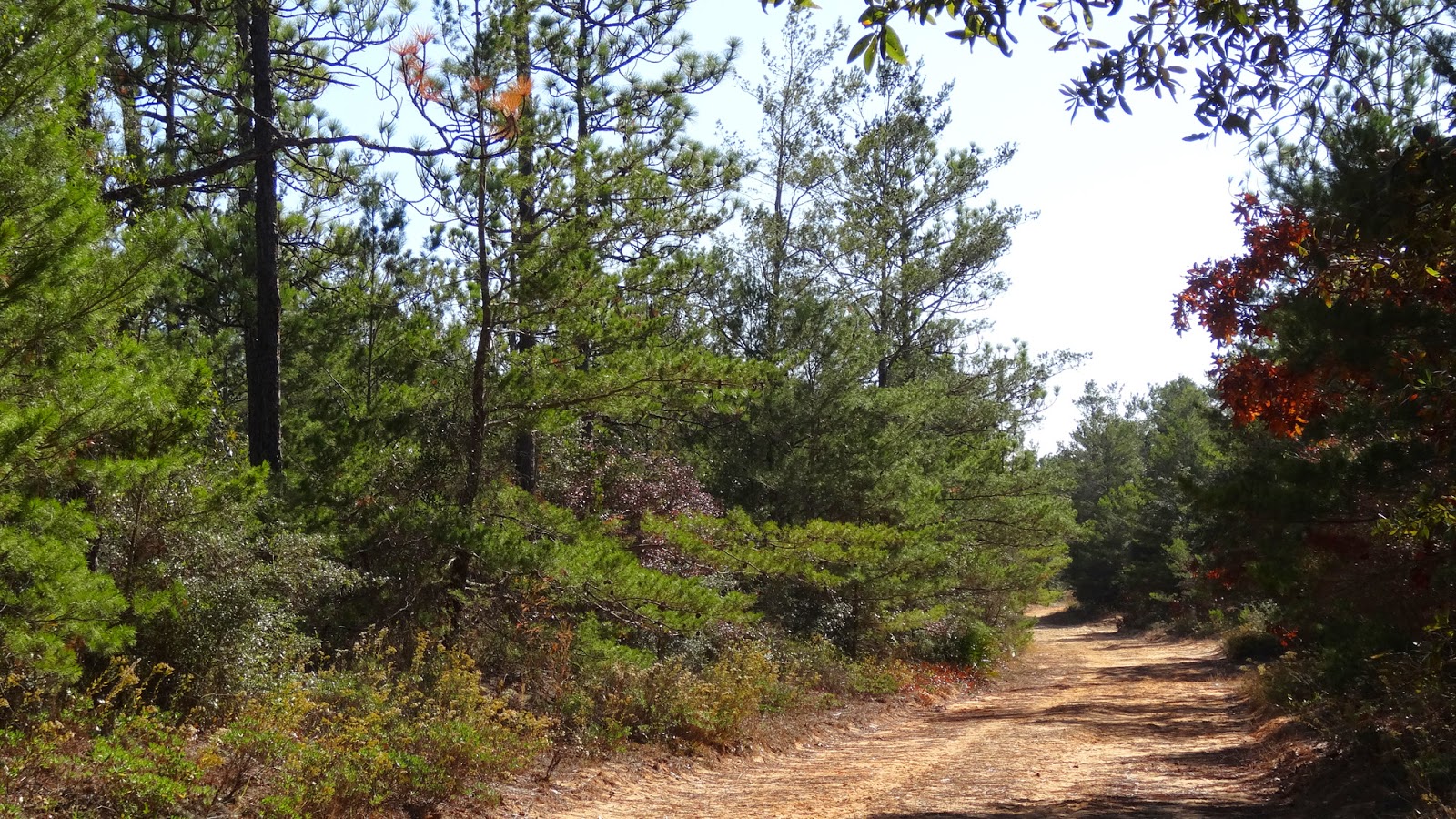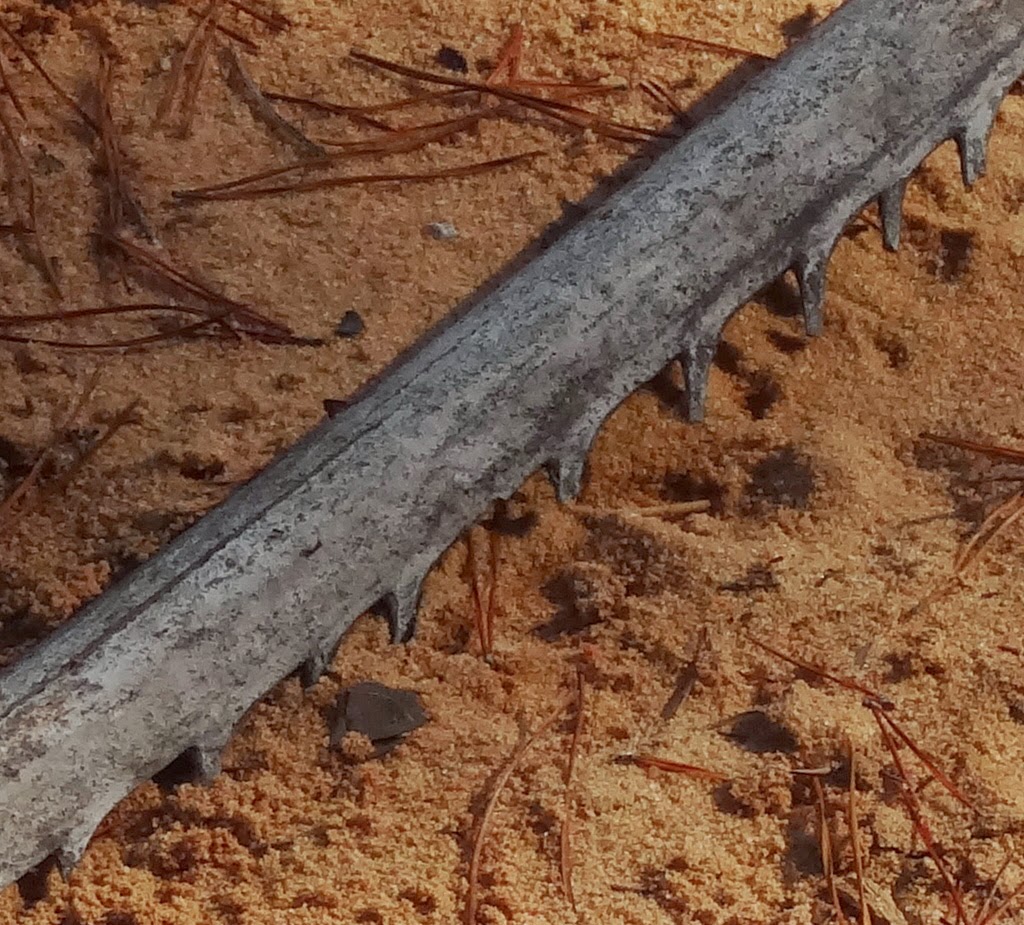There's little like a vacation to stir up the blood and help you see new perspectives. We've just returned from a 10 day trip to the Florida panhandle, where we celebrated Thanksgiving with our kids and began to get a picture of what the coming years might hold for us. One of the many enjoyable activities while we were there was a relaxing walk through a recreational area on Eglin Air Force Base. As winter really starts to descend here in Kansas and throughout much of the country, I thought it might be fun to share some of the plants I saw just a week ago, in a warmer clime....
While Greg, Jess, Sean, and "the girls" walked on ahead, intent on true exercise, I lingered behind to take photos along the old roadway. Truthfully I was surprised by the variety of plants I saw. Even more truthfully, I was surprised by how many species I remembered from my gardening days in Mobile!
As I started off down the trail, my first impression was of food. Lots and lots of food...for birds and other animals. Food seemed to be available everywhere I looked.
There were vividly red yaupon holly (Ilex vomitoria) berries crowding each other in the sunlight.
Along with the crimson yaupon berries were other berries, such as these deep blue, greenbrier (Smilax sp.) berries, and lots and lots of seeds. Goldenrod (Solidago sp.) seedheads were particularly full of feathery goodness.
This feathery goldenrod plant joined with beautyberry (Callicarpa americana) berries to offer the local wildlife a feast.
As I walked and looked and took photos, the old phrase, "Toto, we're not in Kansas anymore!" kept echoing through my head. No, it for sure wasn't Kansas. Sometimes it amazes me how few plant species are found both along the Florida/Alabama coastline and up here in the prairie land. Certainly there are genuses that are in both areas, but the species are quite separate.
Between Kansas and the Gulf Coast, the feel of the plant communities is very different too - which is hardly surprising. Sporting a covering of pine needles and a diversity of moss and lichen on a heavily sandy soil, this view of the woodland floor is typical for the area we were visiting.
Towering over the rest of the vegetation were the longleaf pines (Pinus palustris). Historically, these keystone plants formed massive open forests which predominated all along the southern coastal plains, from Virginia around the corner to Texas, until about 100-150 years ago. First the majestic longleafs were tapped to make turpentine and cut to make ship masts, then later they were cut down to burn in steam engines as the country expanded. Of course, their wood was also used in building as well. The land that was cleared was either put into agriculture or replanted with faster growing slash or loblolly pines. Within just a few decades, almost all of the longleaf forests were gone. Nationwide, a University of Florida study done in 1997 found only 15 sites with virgin longleaf pine forest left, totalling about 1600 acres.
A typical understory plant throughout much of the area, saw palmetto (Serenoa repens), gives a vaguely tropical feel to the woodlands. It is a true native (unlike most of the others palms and palm-like plants you see along the Gulf Coast) and it is very valuable for wildlife.
Here is a remnant of the "stem" of one of the big fan leaves found on saw palmetto. You can see where the name "saw" comes from! It makes me think of fossil dinosaur jaws whenever I see it.
Usually not considered a beneficial plant, there was a lot of greenbrier (Smilax sp.) in the understory along the path, too. I actually like greenbrier for its wildlife versatility - the berries are great food for birds and other animals, while (as is typical for native plants) the leaves are larval food for caterpillars of several different moth species such as the turbulent phosphila and the ruby quaker. Note: the names are cool, but the adult moths are pretty cryptic, a.k.a. drab. Still, they too are food for numerous other animals. Many greenbrier vines are bristling with thorns and can serve as excellent shelter and nest protection for birds and other small animals.
This essentially thornless greenbrier had a few healthy berries to share, and you can see the parallel leaf veins that help identify it as a Smilax.
One find that surprised me was what I think was a nicely sized American holly (Ilex opaca). While they are native to the area, I didn't see them very often when we lived in Mobile.
Scattered in small clusters amongst the broad leaves, the holly berries were bright red and looked great, but they didn't put on as much of a show for the camera as the yaupon berries did. With its yellowish green leaves, American holly is widely used in crosses with other species, but isn't
commonly found as a straight species in the nursery trade.
Walking back along the trail, though, and thus seeing from a different direction with a different angle of light, the leaves of the holly do look much darker.
To eyes accustomed to fall further north, the woodlands still look very green, but signs of fall were everywhere. While I've talked about the colorful berries and fluffy seedheads, there was also some fall color. An excellent source of fall color in longleaf territory is sparkleberry, Vaccinium arboreum. In the blueberry genus, sparkleberry has tiny blue berries that are snatched up by birds as soon as they ripen, which is earlier in the year, but their shiny leaves color beautifully and remain on the plant for a long time. This individual was a beautiful maroon...
while across the path and down the way a bit, another sparkleberry went in for oranger and golder tones.
Speaking of orange and gold, there were a few yellow-gold blooms still gallantly blazing, although I don't know what they were, ...
and a male monarch was traveling the path with me, too. He rested on a yaupon long enough to give me a "photographic opportunity" before continuing on his journey. I wonder if he'll make it to Mexico or not?
There are 2 other plants that I want to highlight from this walk, but I think I'll separate them out into another post or two.
Meanwhile, Greg, Sean, Jess, Gabby and Dahlia got done walking and have come looking for me - so I'll end this ramble. Hope you enjoyed my glimpse of the south land in your chilly December!
Sunday, December 07, 2014
"We're Not in Kansas Any More!"
Labels:
Beautyberry,
Family,
Goldenrod,
Holly,
Longleaf Pine,
Monarchs,
Saw Palmetto,
Seasons,
Smilax,
Sparkleberry,
Vacations,
Yaupon
Subscribe to:
Post Comments (Atom)



















3 comments:
Sounds like you had a great get away and fun times with family. Beautiful area. Thanks for sharing all the photos. Such a different autumn than here.
What a nice collection of finds along the way. It always amazes me what you can find when you keep your eyes open.
The beautybush looks so out of place in the wild, hard to believe it's native.... unlike all the other thorny, prickly, and pokey plants which seem to love Florida. Not exactly a barefoot with shorts kind of ecosystem!
Bittster, You are so VERY right about the Florida ecosystems not being great for barefoot and shorts! (At least not away from the beach, at any rate.) Of course, mosquitoes limit shorts too!
I also agree with you about beautyberry looking out of place. It actually looks out of place in many situations, but the birds think it fits in just fine!
Post a Comment